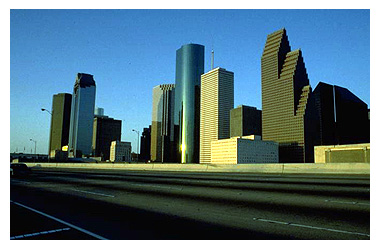
Office: HGH 210; phone: (408) 924-5378
Email: wooda@email.sjsu.edu
Web: http://www.sjsu.edu/faculty/wooda

|
Dr. Andrew Wood Office: HGH 210; phone: (408) 924-5378 Email: wooda@email.sjsu.edu Web: http://www.sjsu.edu/faculty/wooda |
Mike Davis, in his chapter "Fortress Los Angeles," approaches the marginalization of public life in urban centers from a more radical direction than Garreau - arguing that recent attempts to "revitalize" fading downtowns rest upon a stark desire to construct militarized spaces designed to terrorize non-white, non-wealthy populations. Though you may reject some of his implications, he makes a compelling point that urban public places no longer offer heterotopian safety valves where groups of different class and background may interact. [Note 1]
The new Downtown is designed to ensure a seamless continuum of middle-class work, consumption, and recreation, insulated from the city's "unsavory" streets. Ramparts and battlements, reflective glass and elevated pedways, are tropes in an architectural language warning off the underclass Other. Although architectural critics are usually blind to this militarized syntax, urban pariah groups - whether young black men, poor Latino immigrants, or elderly homeless white females - read the signs immediately. (p. 159)
The urban core, drained of its cosmopolitan vibrancy and rebuilt as a militarized dystopia, appears to offer little hope for public life. It is little wonder that Robert D. Kaplan recalls that during a recent trip to the LA Basin: "Rather than people I saw only cars and enormous parking lots" (1998, n.p.).
Writing in the Los Angeles Times, Davis (1994) warned of a second urban crisis - in which suburbs, imagined by Ebenezer Howard and world's fair planners as "garden cities," would suffer the same fate as urban centers. A host of ills, ranging from defense industry cutbacks to gang culture to throwaway architecture, threatened suburbs just as families sought to escape the downtowns of once great cities. Social planners and popular culture mavens depicted the suburbs as clean, safe, and quiet, so those left behind in the "white flight" of the fifties and sixties set out for their green vistas and gently curved streets.
Where did urban and suburban prosperity go? Demographer Joel Garreau provides an answer with his influential book, Edge Cities: Life on a New Frontier. Originally published in 1991, Edge Cities, is one of the most significant books on urban life and planning in a generation [Note 2]. While some critics deride his expansive prose and broad conclusions as pop-sociology, many students of public life continue to find that Garreau's "anticipatory archaeology" offers powerful insight on contemporary America. With a nod toward the ideological framework provided by Davis, we will focus most of our exploration of the postmodern city on Garreau's notion of edge cities.
In a Washington Post article, Garreau (1999) describes edge cities, numbering almost 200 in the United States, as the final crest of three waves. The first began with the emergence of suburbanization as families left the cities in droves and took their tax dollars with them. The second wave, the "malling of America" in the 1960s and 1970s, occurred when commercial businesses began to flee the urban cores and enter the suburban gardens. The third wave, the rise of edge cities, complete the process as white-collar jobs bloom where people live and shop. Intriguingly, Garreau suggests that the growth of edge cities played a key role in the women's movement by blurring gendered domains of home and city. No longer could the suburbs be termed "sororities with kids":
Unlike the classic urban core, typically situated on the convergence of natural features, edge cities usually grow along the stretches and near the intersections of interstates - frequently those that ring and bypass downtown areas. In this way, Silicon Valley may be considered an edge city that sprawls along interstate 101 between San Jose and San Francisco and interstates 680 and 880 between San Jose and Oakland. According to Garreau, an edge city:
Regarding the latter quality, an online essay from the La Jolla Institute puts it best: "[Edge Cities] are classically post-Historic." In other words, unlike cities which possess multiple layers of history, edge cities hasten to create spaces of community in a vacuum where none have emerged organically. Themed restaurants and faux-architecture offer partial-pasts in environments too busy to allow real ones to form.
In his chapter "Boston: Edge City Limits," Joel Garreau explores the development of edge cities as ecologies dependent upon five critical factors. The first, insurmountability, simply indicates that physical and social factors push edge cities into the vacuum where growth can occur. It is for that reason that the Boston "beltways" are less concentric circles than ever expanding arcs heading away from Boston Harbor. Large-scale growth is impossible on the water, so it must head west. The second factor, affordability, demonstrates how edge cities follow the availability of housing. Conversely, they fail where inflation outstrips wages. Boston in the 1980s offers an alarming vision of Silicon Valley in the next decade as workers must live further and further away from their jobs, so far that it makes little sense for many to stay. Those who do are frequently zoned into housing so dense that their homes resemble nineteenth century tenements:
 The third factor, mobility, refers to the ease of workers trying to get
around town. The fact that mobility is almost always defined according to the
needs of automobiles certainly shapes the design of public life in edge cities.
In Boston, New York, and other urban cores, mobility is nearly impossible during
the workday. Thus, edge cities thrive to the degree that they can accommodate
more and more vehicles. The fourth factor, accessibility, naturally follows
the third: an edge city cannot be too remote from urban resources - either physically
or electronically. No matter how inexpensive it may be to live in, say, Montana,
an edge city cannot be excessively distant from a major airport or cell phone
connection. The fifth factor, "nice", refers to the tangible and not-so-tangible
quality-of-life quotient: how "nice" would life be if a firm situated its new
headquarters in a particular location? How willing would the location's inhabitants
be to risk their "nice" locale for the sake of a new company and its benefits?
The third factor, mobility, refers to the ease of workers trying to get
around town. The fact that mobility is almost always defined according to the
needs of automobiles certainly shapes the design of public life in edge cities.
In Boston, New York, and other urban cores, mobility is nearly impossible during
the workday. Thus, edge cities thrive to the degree that they can accommodate
more and more vehicles. The fourth factor, accessibility, naturally follows
the third: an edge city cannot be too remote from urban resources - either physically
or electronically. No matter how inexpensive it may be to live in, say, Montana,
an edge city cannot be excessively distant from a major airport or cell phone
connection. The fifth factor, "nice", refers to the tangible and not-so-tangible
quality-of-life quotient: how "nice" would life be if a firm situated its new
headquarters in a particular location? How willing would the location's inhabitants
be to risk their "nice" locale for the sake of a new company and its benefits?
In the 1980s, edge cities such as those surrounding Boston grew quickly. Yet, despite being anchored in the new economy of computer hardware and software, many failed. How, Garreau asks, "could such a brainy, high-technology boom collapse" (p. 77)? The answer is the introduction of a fatal flaw, such as a lack of affordable housing that almost inevitably kills an edge city. Here, Mike Davis and Joel Garreau meet, despite their differing ideological standpoints. Urban life - whether at the core of a downtown metropolis, in the winding cul-de-sacs of a suburb, or along the freeway of a postmodern edge city - becomes rapidly dystopian once the ecological balance of those five factors is lost. For this reason, both Davis' and Garreau's theses will be even more essential when we explore Silicon Valley as tenuous public life in a forthcoming discussion.
To other critics, edge cities are little more than glorified suburbs - the implications of federal influence over public life. For example, freelance author John McCrory (1997) claims that edge cities simply illustrate federal influence over urban development. He notes four factors that have shaped the emergence of Edge Cities since the Second World War: (1) federal transportation policy that favors private automobiles and trucks over mass transportation, (2) federal support for single-family detached homes away from the city core, (3) federal tax policies that foster corporate investment away from the cities, and (4) federally mandated growth in defense spending that subsidizes the movement of industries away from metropolitan areas.
Can the emergence of edge cities be explained by federal policy alone? As we have discussed before, the modern seeds for America's apparent flight from urban cores were planted in the mid-nineteenth century when romantic and idealistic rejection of industrialization caught public fancy in Europe and the United States. The Victorian city was a dank, smoky, dangerous place in much of the public imagination. Regardless of federal prodding, city inhabitants raced to escape its murk and misery as quickly as they could. They sought green spaces and gentle, rolling hills and waxed mythological about the gardens even as they rejected the Machine. This contest of machine and garden shapes public life at least as much as twentieth century federal policy. [Return to text].
References
Davis, M. (1994). The suburban nightmare. Los Angeles Times, p. M1.
Davis, M. (1999). Fortress Los Angeles: The militarization of public space. In M. Sorkin's (ed.), Variations on a theme park: The new American city and the end of public space (pp. 154-180). New York: Hill and Wang.
Garreau, J. (1991). Edge city: Life on the new frontier . New York: Doubleday.
Garreau, J. (1999, November 8). Postcards from the edge city. Washington Post, p. A1.
Kaplan, R.D. (1998, August). Travels into America's future. Atlantic. Available online: http://www.theatlantic.com/issues/98aug/amfuture.htm
Kling, R., Olin, S., & Poster, M. (1996). Beyond edge cities: The dynamism of postsuburban regions. No longer available online.
La Jolla Institute. (1999, January 23). Does place matter? No longer available online.
McCrory, J. (1997, April ). The edge city fallacy. McCrory's Pause. Available online: http://johnmccrory.com/pause/city/paper_edgecity.html